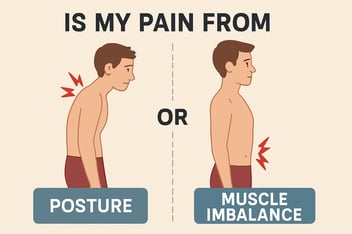How to Tell If Your Muscles Are Weak, Tight, or Both
Muscle pain, stiffness, and fatigue are common complaints among students, office workers, and active individuals in Erin Mills and Mississauga. Understanding whether your discomfort is caused by muscle weakness, tightness, or a combination of both is essential for proper treatment and prevention.
At Aurika Wellness, our physiotherapists assess muscle function and provide targeted interventions to restore balance, improve mobility, and prevent injuries. In this blog, we’ll explore how to recognize these conditions, their causes, and strategies to address them effectively.
Muscle weakness occurs when muscles are unable to generate sufficient force to perform normal movements. Weakness may result from inactivity, poor posture, prior injury, or underlying medical conditions.
Signs of weak muscles include:

Understanding Muscle Tightness
Muscle tightness occurs when a muscle is shortened or contracted, often due to repetitive use, prolonged sitting, or insufficient stretching. Tight muscles can limit range of motion and create discomfort.
Signs of tight muscles include:
Often, weakness and tightness coexist, creating a muscle imbalance. This occurs when certain muscles are tight and overactive, while opposing muscles are weak and underactive. Common examples include:
At Aurika Wellness, our physiotherapists assess muscle function and provide targeted interventions to restore balance, improve mobility, and prevent injuries. In this blog, we’ll explore how to recognize these conditions, their causes, and strategies to address them effectively.
Understanding Muscle Weakness
Muscle weakness occurs when muscles are unable to generate sufficient force to perform normal movements. Weakness may result from inactivity, poor posture, prior injury, or underlying medical conditions.
Signs of weak muscles include:
- Difficulty lifting or moving objects that were previously manageable
- Fatigue during routine activities such as climbing stairs or walking
- Poor stability or frequent loss of balance
- Visible muscle atrophy or loss of tone

Understanding Muscle Tightness
Muscle tightness occurs when a muscle is shortened or contracted, often due to repetitive use, prolonged sitting, or insufficient stretching. Tight muscles can limit range of motion and create discomfort.Signs of tight muscles include:
- Reduced flexibility or difficulty performing full movements
- Stiffness in the neck, shoulders, or back after long periods of sitting
- Pain that worsens when stretching or attempting to move
- Muscle knots or palpable tension in specific areas
Tight muscles can contribute to poor posture, joint strain, and increased risk of injuries, especially during exercise or repetitive activities.
Often, weakness and tightness coexist, creating a muscle imbalance. This occurs when certain muscles are tight and overactive, while opposing muscles are weak and underactive. Common examples include:
- Tight chest muscles with weak upper back muscles, causing rounded shoulders
- Tight hip flexors with weak glutes, leading to lower back discomfort
- Tight hamstrings with weak quadriceps, affecting knee stability
Muscle imbalances alter movement patterns, reduce efficiency, and increase the likelihood of pain or injury over time.
How Physiotherapy Helps
A physiotherapist can determine whether your muscles are weak, tight, or imbalanced through a comprehensive assessment. This usually involves: - Posture and movement analysis: Observing your alignment during everyday tasks and exercises.
- Strength testing: Evaluating major muscle groups to identify weaknesses.
- Flexibility assessment: Measuring range of motion in key joints and muscles.
- Functional evaluation: Checking how muscles work together during daily movements and athletic activities.
Based on this assessment, the physiotherapist develops a customized plan to correct imbalances. This may include: - Strengthening exercises for weak muscles
- Stretching routines for tight muscles
- Manual therapy or massage to relieve tension
- Posture education and ergonomic recommendations
Through consistent treatment and guided exercises, many patients regain balanced muscle function, improved posture, and reduced pain.
Practical Tips to Address Weakness and Tightness at Home
Even without professional sessions, there are strategies to support muscle balance: - Incorporate daily stretching: Target commonly tight muscles such as hip flexors, chest, and hamstrings.
- Strengthen underactive muscles: Focus on back, glutes, and core through bodyweight or resistance exercises.
- Move regularly: Avoid prolonged sitting; take breaks to stand, walk, or perform mobility exercises.
- Foam rolling: Use a foam roller to release tension in tight areas like calves, quads, and IT band.
- Monitor posture: Ensure your workstation, backpack, and seating support proper alignment.
Small, consistent changes can prevent muscle imbalances from worsening and reduce the risk of chronic pain.
When to See a Physiotherapist in Erin Mills
Consider It’s important to seek professional help if: - Pain or tightness persists despite self-care measures
- Weakness limits daily activities or exercise performance
- You experience recurrent injuries or compensatory pain in other areas
- You want a structured, personalized plan to prevent future issues
At Aurika Wellness, our physiotherapists in Erin Mills, Mississauga, specialize in assessing and correcting muscle imbalances. With direct billing options, patients can access care conveniently without upfront payments if their insurance benefits cover it.
FREQUENTLY ASKED QUESTIONS
How can I tell if my muscles are weak or just tired?
Weak muscles cause consistent difficulty performing tasks, whereas fatigue usually resolves with rest. A physiotherapist can assess strength and function accurately.
Can stretching alone fix muscle imbalances?
Stretching helps relieve tightness but does not address weakness. A combination of stretching and strengthening is required to restore balance.
How long does it take to correct muscle imbalances?
Mild imbalances may improve in a few weeks with consistent exercises; more severe or chronic imbalances may take several months of guided therapy
Is physiotherapy covered by insurance in Mississauga?
Many insurance plans provide coverage. Direct billing at Aurika Wellness ensures eligible patients pay $0 upfront.
%20-%20Edited.png?width=150&height=103&name=Final%20LOGO@4x%20(2)%20-%20Edited.png)



